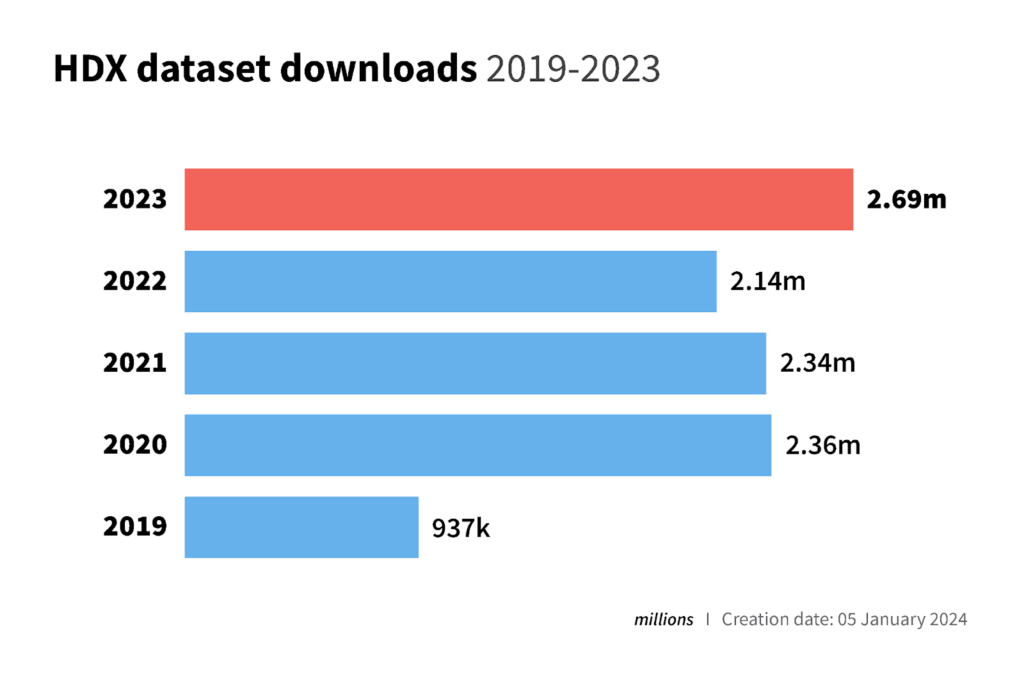Share
In 2023, the Humanitarian Data Exchange (HDX) continued to deliver on its goal of making data easy to find and use for analysis of humanitarian operations. The platform was accessed by 1.4 million people in 230 countries and territories, maintaining a similar number of users over the past several years but with a 25 percent increase in the number of datasets downloaded. Below we provide a closer look at the trends from 2023 and highlight a few of the new organizations that joined our community.
 There are 237 organizations sharing their data on HDX. Existing and new organizations shared 1,800 new datasets covering crises ranging from Gaza to Sudan. By the end of December 2023, HDX hosted 20,500 datasets which were downloaded almost 2.7 million times throughout the year. Over half of the data on HDX is now shared programmatically, reducing the need to manually add individual datasets. This shift to automation through data pipelines is a sign of increased sophistication among our data partners and something we plan to leverage in the HDX technical roadmap.
There are 237 organizations sharing their data on HDX. Existing and new organizations shared 1,800 new datasets covering crises ranging from Gaza to Sudan. By the end of December 2023, HDX hosted 20,500 datasets which were downloaded almost 2.7 million times throughout the year. Over half of the data on HDX is now shared programmatically, reducing the need to manually add individual datasets. This shift to automation through data pipelines is a sign of increased sophistication among our data partners and something we plan to leverage in the HDX technical roadmap.
 In 2023, we created four HDX crisis pages to support the response to the Türkiye/Syria earthquake, the Morocco earthquake, Libya flash floods and hostilities in Gaza. Although we are no longer maintaining the Horn of Africa Drought Data Explorer, the underlying datasets on food insecurity, seasonal rainfall and humanitarian operations remain on HDX.
In 2023, we created four HDX crisis pages to support the response to the Türkiye/Syria earthquake, the Morocco earthquake, Libya flash floods and hostilities in Gaza. Although we are no longer maintaining the Horn of Africa Drought Data Explorer, the underlying datasets on food insecurity, seasonal rainfall and humanitarian operations remain on HDX.
We welcomed 24 new organizations to HDX in 2023. A few highlights include:
- United Nations Relief and Works Agency for Palestine Refugees in the Near East (UNRWA) provides education, healthcare, social services, and emergency relief to Palestinian refugees in areas including the West Bank, Gaza, Jordan, Lebanon and Syria. Since October, they have shared three datasets on Gaza covering displaced people in UNRWA shelters, aid trucks accessing Gaza, and the number of killed and injured civilians.
- Google Research aspires to make discoveries that impact everyone and release their findings as open source. Following the Morocco earthquake in September, they shared a building footprints dataset which contains the outlines of buildings derived from high-resolution satellite imagery. Since then, they have shared four more datasets with imagery for Libya, Afghanistan, Japan and Reunion Island.
- IGAD Climate Prediction and Applications Center (ICPAC) is accredited by the World Meteorological Organization to provide climate services to 11 East African countries. Their data includes historical tropical cyclone paths and impacts as well as combined drought indicators which are used for detecting and monitoring areas that are either affected or have the potential to be affected by meteorological, agricultural and/or hydrological drought.
- WFP Advanced Disaster Analysis & Mapping (ADAM) is an operational system for collecting, analyzing and mapping geospatial and socio-economic information following rapid onset humanitarian emergencies. So far, ADAM has shared over 60 disaster alerts datasets covering floods, earthquakes and tropical storms.
We also want to acknowledge the long-standing data contributions from partners such as ACLED, the Humanitarian OpenStreetMap Team, Integrated Food Security Phase Classification, IOM, REACH, UNFPA, UNHCR, UNOSAT, WFP and our own OCHA field offices.
We will be providing more insights about the data on HDX in The State of Open Humanitarian Data 2024 report, which will be released in February. We look forward to working with all of you in the year ahead – a year that marks the platform’s tenth anniversary. We are excited about the potential of the next ten years and look forward to continued data partnerships. Please reach out with questions or comments at hdx@un.org.